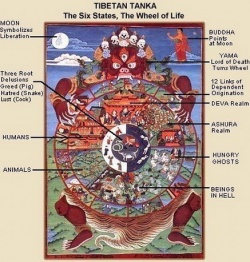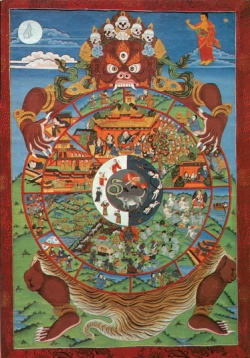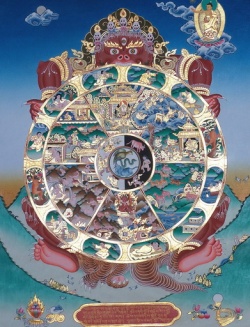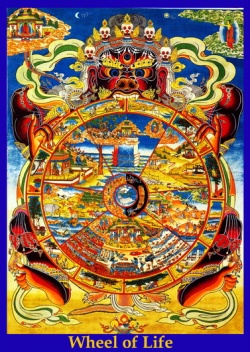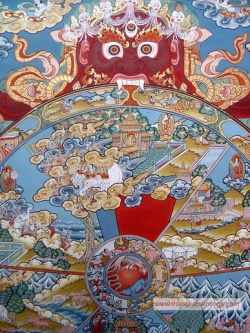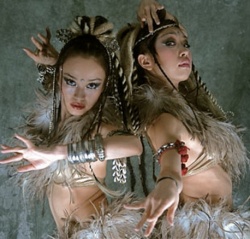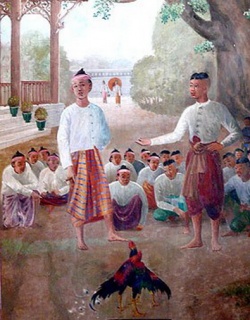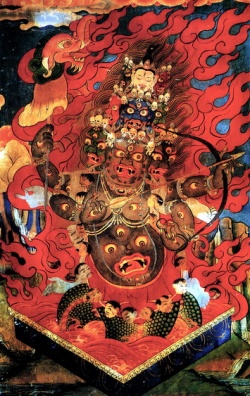The Tibetan Wheel of Life
By Dhammachari Bodhanada
Introduction:
The Tibetan Wheel of Life is perhaps the most common of all pictures in Buddhist Art and can still be soon on the walls of Monasteries temples and painted scrolls all over Tibet and Buddhist countries bordering the Himalayan region. It was at one time also very common in Buddhist India, but the Moslem invasion was so complete in its destruction of Buddhism in India only or two examples of it remain in the rock cut Caves of Ajanta and Ellora in the state of Maharastra in India. A good deal of misunderstanding surrounds its rich imagery and symbolism and I myself have often heard it described by Thanka painters in Kathmandu as being either an almanac, astrological chart or a complex Tibetan calender. The Wheel of Life in fact represents a very complete view of mundaine existence in its depths and heights. The origins of this fascinating pictures are a little obscure but there are two or three sources which may account for its creation. According to the Divyavadana or Divine Heroic Feats of The Buddha and His disciples, the origin model of the Wheel of Life was painted over the gateway of the Veluvana Vihara at Rajagriha on the personal instructions of The Buddha who indicated exactly how the work should be done. This instruction of The Buddha, so the text relates, was inspires from the activities of on of his chief disciples, Maudgalyana. Due to his Monastery of psychic powers, Maudgalyayana was able to visit all the beings in the different realms of existence, see them in differing states of pain or pleasures and was aware of the causes which brought them to these planes and states. Apparently this was only just one of Maudgalyayana’s abilities. He also had extraordinary capacity to emphasize with others, see into their minds and hearts, feel their joys and pain and understand how they come to be as they were. Because of this Maudgalyayana was able to communicate very effectively. If senior Monks were having trouble with a Disciple who may be losing inspiration he would send him to Maudgalyayana who would inspire him and teach him well to such an extent that the Disciple would lead the Spiritual Life again with renewed energy Maudgalyayana had the Power to reinvinigorate flagging Zeal by showing his own deep Insight into the various conditions of exiatence.
The Buddha noticing this commented that there were not enough people like Maudgalyayana to teach all those who needed him. He therefore proposed that a picture should be painted representing Maudgalyayana’s teachings and he instructed his followers to paint the Wheel of Life depicting the different realms of existence and the process which underlie them at the entrance to every Monastery. At each a Monk was stationed to explain the picture to visitors and novices. From this we can see that the basis of the image and its symbolism comes from direct experience. The picture can work on us not by giving us a clear explanation in relation terms of reality but by appealing to our imagination with its rich and strong use of imagery. As second explanation for its creation comes from a Tibetan legend which attributes the origin to The Buddha himself and describes him outlining the Wheel to his followers in grains of rice in a paddy field. Perhaps a third explanation might be that it represents in visual terms an amalgamation of some of the more fundamental teachings in Buddhism such as Dependent origination (Patityasamutpada), the laws of Karma, the three Klesas and the types of willed action, Kusala and Akusala. Whatever the reasons behind its creation the symbolism of the Wheel of Life can still have relevance and meaning for us today if we have some understanding of the images in the picture. The picture is a powerful and complete vision of mundane reality. It is a picture or image of the whole of sentient existence which includes the Human, Animal, Hell and Heaven realms and all the beings therein. It not only represents mundane existence but also describes the mechanism which drives it, in the reactive, unenlightened, conscious Mind. But the Wheel of Life not only represents pictorically the whole of sentient existence. The Wheel of Life is in fact a mirror. When we look at it or into it we are in effect looking at ourselves. We see ourselves in the picture, our heights and depths, our reactivity and potential creativity. We see all we have been, and what we now are as well as what we could become. The Wheel of Life not only represents sentient Life on different levels but also perhaps represents Life on the Psychological Mental., Conscious and subconscious levels. For a fuller understanding of these ideas we shall explore the different images in the picture.
The Central Hub;
Like any Wheel the energy which generates its motive force comes from the center and this is just as true for the Wheel of Life. The energy or causes which create the whole dramaof existence as depicted in the Wheel of Life originates from the central hub of the Wheel and which symbolizes the conscious, unenlightened Mind. Within this Central portion of the picture we see three Animals, a pig, a snake and a cock. Usually, and for good reasons, these are depicted biting the tail of the one in front so that they create a circle. These Animals are used in the picture because they best represent the animal like tendencies in our Mind which cause us to traverse the Wheel and to take Rebirth again and again. The first animal in this vicious circle is the pig. The Pig represents a very deep and fundamental Delusion (Moha) or Ignorance. This is not Ignorance in any superficial way but is more a fundamental misunderstanding or misconception as to our selfnature. Because of a (self) awareness imputed upon the Aggregates this gives rise to experience of (I) and (we) or the notion of a self existing personality. Because of this notion of self or the ego this conditions the arising of desires (Irsna). This desire is represented by the cock, always feeding or in search of more Food to peck at. The reactive conscious Mind is always in search of new experience or desires the repitition of familiar ones. This desire can be of many types not just for material ones. But also for inmaterial things which can affirm the ego, Fame, Power, position as well as more Wealth and riches. Desire can have both a negative and positive expression. Here we are concerned with its negative aspect which are rooted in Greed, Hatred and Delusion and which reinforce our most basic ideas concerning ourselves and which heeps us bound to the cycle of birth and Death. When Desire is rooted in Compassion Generosity, and Awareness this provides the ‘motive force’ for our eventual ‘escape’ from the cycle of becoming, for self transcendence and final Liberation.
When desire in its more negative aspect is blocked or inhibited we experience frustration, irritation, Anger and hatred. This is represented best by the snake which is ready to strike out when threatened. When this state arises thus can only have the effort of strengthening the ego sense and hence we see the snake biting the tail of the pig and so the whole vicious circle is strengthened.
The Second Circle
The second circle is divided into equal segments. One segment is white and the other is black. In the white segment we see various human beings moving upwards. They are moving upwards with very happy, very peaceful even very joyful, expressions on their faces. This half of circle represents the effects of all of our willed actions (Karma) (of Body, speech & Mind) when rooted in Compassion, Generosity and awareness and which lead us to experience happy, peaceful and joyful states of Mind as a result. In the other half of the circle, the black half, we see something rather different. Here we see human brings plunging downwards with expressions of horror and terror on their faces. They are usually depicted as being naked and claimed together dragged along by a couple of demonic looking beings. This half of the circle represents the Suffering we eventually experience, as a natural consequence, the results of all of our negative actions, again of Body, speech and Mind. The two demonic beings in the black segment who seem to be dragging the other terrified beings along represent the often, strong negative forces in the Mind which can sometimes get out of control and we can often be pulled along by them without drawing much control over ourselves as when very often we find ourselves at times flying into a rage or speaking uncontrollably in a negative way towards others. As a consequences we experience some Suffering. The black and white halves of this circle represent the two ways we can act in any situation either with skillfulness (Kusala) or unskillfulness (Akusala). Depending on our motivation towards acting with Awareness and Compassion, or with a self centered Ignorance and unawareness we will experience states of Mind in accordance with our actions. This is perhaps a very important point within the whole of the Buddhist teachings. Our present state of experience both subjective and objective are what we are creating all the time and are not given to us by some outside divine Power and nor they fixed and rigid for all time. Our experience tend to seem fixed because our actions are often fixed and habitual.
Two options lie open to us. We can either ascend and develop ourselves by cultivating a greater self-awareness and perform actions which are perhaps less self centered and rooted in Love and Compassion or we can descend experience the frustration and pain of all our actions whatever course we take we will be creating the conditions for our experience in the future both within this Life and also for what plance of existence we eventually take Rebirth in the following take Rebirth in the following Life. Because we are quite complex beings are never just performing skillful or unskillful actions most of the time. During one hour we probably perform a number of actions of Body, speech and Mind some subtly skillful and healthy. It will be the more dominant tendencies which we create will be the condition for our future experience both in the present Life and in the future lives.
SIX REALMS
The third circle is divided into six segments which represent six realms or actual words of existence, (the realms of the gods, titans, hungry ghosts, Hell being, Animals and humans) living beings are reborn in a particular realm as a result of their Karma and live in that realm until that Karma has been exhausted. Living beings take Rebirth into a particular realm not as a punishment or a reward for past actions, but more, that the Body and the World they come to inhabit is the best expression of their Mental states. This is quite true but there is more to the symbolism of the six segments of the third circle than just this. The six segments of the third circle also represent six states of Mind which we can experience here and now, in our present human existence. Sometimes we can experience these states of Mind so strongly that for the time being we seem actually to be living in another World, in Heaven or in Hell, or among the hungry ghosts etc. It is possible therefore to experience them almost as states of being, rather than just as states of Mind. So we can look at each of the six words in this Light, as states of Mind as well as states of being.
The World of the Gods [Top Gentre]
The World of the Gods represents a state of Mind and existence which is happy, pleasant and a state of relaxation, Contentment and repose. It is a state in which everything goes smoothly, where there are no obstacle, difficulties or problems. It is also a state of aesthetic experience. Rebirth in these higher realm occurs if skillful actions predominated in previous lives, especially if higher states of Consciousness and absorption were cultivated through Meditation or Spiritual practice, in each of the six segments we see the appearance of a Buddha figure usually standing upright and Offering something to the beings in each of The Six Realms. The six Buddhas who appear in each segment represent the Bodhisattva Avalokiteshvara, who is the embodiment of the Compassionate aspect of the Enlightened Mind. The particular object that he holds in each segment is something that is needed by the beings of the World in which he appears. The White Buddha in the God realms is seen playing on a lute a sweet but penetrating melody, the melody of Impermanence. To be born in these realms the very Happiness and Contentment can be dangerous- if not disastrous. When we are happy and content all the time, if we always have it one’s own way and things always go smoothly then we tend to become self satisfied, complacent, even careless and unmindful. We can forget we are mortal, that Life is short and time limited. The white Buddha here does not stand up and deliver a lecture on Impermanence but rather plays the melody of Impermanence on a lute, waking the beings up to the higher Transcendental truths and realities. As has been mentioned these realms can be seen to represent states of Mind and it is true that many people in the modern, technological World are living like the gods with almost everything we could possibly want at the press of a button or switch. It is only through the experience of pain and frustration that we eventually wake up to the face of Impermanence and the ‘Great Dream’.
The World of the Asuras or Titans
This is an aggression, competitive state of Mind. There is a great deal of energy about which all turns outward. There is restlessness, suspicion and jealousy. The Asuras are depicted as fighting with the gods for the Wish Fulfilling Tree (Kalpavrksa). In this realm or state of Mind one is always striving after endless material Wealth, more personal Power etc. It is a state of assertive egotism where one always wants to be better than others and perhaps superior to others or controlling others. The males are often depicted as being tautally built and very strong using force and manipulation while the females here are equally powerful but manipulate others by seduction. The green Buddha who appears in this realm holds a flaming sword, the sword of Transcendental Wisdom. When we are in a state of competitiveness and aggression the next step is for us to develop Intellectual Insight into Truth and Reality. The Asura like being, the titan the enemy of the gods is dominated by hatred and this hatred can be used creatively by being directed towards the realization of Truth. Hatred has the characteristic of wanting to smash through or even destroy the thing hated. We could say that there is a similarity here with Transcendental Wisdom which has also the tendency to destroy and kill but in a more positive sense. Transcendental Wisdom seeks to destroy everything that is illusory, to smash through everything which stands in its way, everything which is not Reality or Truth. The Buddha figure seen in this realm offers the being here the means whereby they can overcome their Anger and hatred and use their energy to a more useful, beneficial purpose, the purpose of developing Insight. If we look around in our present day World it is all too easily to see example of the Asura like being in the World of politics and international business.
THE World OF THE PRETAS OR HUNGRY GHOSTS
The Pretas are often depicted as very weak and faint beings with very large bloated stomachs and theirs pinhole mouths. Their eyes are very large and mournful. Whenever they try to eat Food it turns into excrement or spikes and water turns into Fire. This is the Mental state or physical realm of neurotic desire. Desire is neurotic when it seeks from its more than the object can give or something different from that which the object can give. We can see this with the case of Food. People can usually overeat and in this example it is not the Food they want but something else. Food can be a substitute for something else. So in using objects in this way, and this example applies to many other things, the objects fails to give us the satisfaction we desire and we can be left with the same longing or neurotic desire. We could compare this state to that of the addict who when getting the object of addiction, that objects fails to give any real satisfaction and may be only gives more pain just like the beings in the Pretaloka. The Food and drink which the red Buddha offers to the Pretas in this realm is real Food and drink which they can consume and which does give real satisfaction. This could be seen to be like returning to a state of objectively, seeing what the desired object is able to give us and what its not able to give us. We begin to discriminate that which can give us true Happiness and satisfaction.
THE Hell REALM
This is the World of tormented beings, the Hell beings. This could also be seen to represent acute Mental Suffering, of nervous frustration and Mental breakdown. Ultimately it is even the state of Insanity. There can be many causes for these states and it adds up to states of intense Mental Suffering and is well portrayed by beings in Hell. In the picture there is only represented one picture of Hell but there are in fact many sub levels or many different ways in which we can experience Suffering. This is represented by the numerous tortures that the beings are being subjected to. We usually see beings dragged or led before a monster seated who holds in one hand a mirror and in the other hand a set of scales. This is Yamaraja or Lord of the underworlds. He is not some kind of devilish monster giving punishment to people because of their past unskillful deeds. He really just represents the forces of Karma. The mirror which holds reflects our own Mind, Mental states and past actions which we see as clearly as our own face and which we eventually have to deal with or experience. The scales he holds in this other hand represents the exact working of cause and effect or Karma. The smoke colored Buddha who appears in the Hell realm offers the being amrita, nectar or ambrosia. The nectar gives the beings ease from their Mental torture and but it can also be seen as a synonym for Nirvana itself which is what brings in the Hell realms actually need above anything else. When Suffering has reached the intensity found in the Hell realms only amrita or Nirvana can really pacify the intense Suffering found there.
The Animal realm
This is the World of Animals with simple sense-Consciousness simply concerned with purely sensual indulgence. In this state one is interested in only Food, sex and simple material comforts. When these desires are met and satisfied the animal is quite gentle and tame, but when they are frustrated they can become dangerous like a wild animal. Whether it is possible for us to behave like one at times. We can at times be living just like Animals, passive victims of our sense desires and instincts, living for the sake of Food, sex, sleep and survival alone (very often in quite sophisticated ways.) The blue Buddha is showing the Animals a book. This means that when we are in a state of barbarism and savagery, the state represented by the Animals, the next step for us is simply to become civilized, to make ourselves acquainted with the arts and sciences, the cultural Life of mankind, because these things have a refining influence. It is difficult, if not impossible, to go from a stage of savagery and barbarism straight into the Spiritual Life without passing through the intermediate stage of being civilized. We see historically that Buddhism in the East was always the bearer of culture. It took not only the Spiritual teaching of Buddhism all over Asia, but it also took the culture of the East into a much higher level. We are told in the Mahayana that the Bodhisattva, the ideal Buddhist, should be a master of arts and science.
The Human realm
This is the realm or state of distinctly human Consciousness. It is neither ecstatic nor agonized, neither fiercely competitive nor mindlessly sensual, nor yet neurotically desirous. In this state the true human being has the capacity for self awareness and of the World and is also mentally and emotionally healthy. The human being is unique in his potential, with his self awareness and his ability to communicate and inspire, the way is open for unlimited development of greater degrees of awareness and levels of being. This is the truly human state, but it is the state which most ‘human beings’ only occasionally or perhaps never experience. One chief danger for us is conceit and pride. Dazzled by our technological achievements we can believe ourselves to be the superior species in the Universe. These are serious barriers to our being receptive to others, essential for both World peace and individual development. The saffron colored Buddha appears in the Human realm holding a staff and a begging bowl, which are the marks of the religious seeker and the Spiritual Life in general. This means when we find ourselves in truly human state, the next step for us is to devote ourselves wholeheartedly to the task of Spiritual development. Once we have reached the human state this should be our main interests in Life, to develop greater degrees of self awareness and hence develop our potential. In so doing we would be making the next step in our development which is perhaps our Spiritual ‘Evolution’.
The Outer Circle;
The Twelve Links;
The outer circle represents again in pictorial Form what is commonly referred to as Dependent origination (Pratityasamutpada). This is the step by step process in the events which conditions and shapes the individual Consciousness from moment to moment and as it takes Rebirth in the different realms. Looking at the pictures in a clockwise order and starting from the top the first picture usually shows a blind man either being led along or walking with a stick, this is 1) Ignorance (Avidya) This is not Ignorance in any sort of rational sense but more of a deeper fundamental Delusion as to our self nature and the nature of the World and our experience. It is a failure to perceive ‘things’ as they actually are (yathabhuta).In a state of unenlightenment we build up views about ourselves, others, and the World. From this Form a character which can only act in an unenlightened way. This conditions the arising of 2) The Karma Formation (samskara). These are the ‘formative’ or Rebirth producing psychological factors which is represented by a potter making pots. This picture represents our volitional and habitual tendencies which shape our character. Our actions of Body, speech and Mind would and shape our character and hence our experience anew. We can look at the first picture as pertaining to the previous Life in dependence on which the present Rebirth occurs. In dependence upon the Karma formations there arises 3) Consciousness (Vijnana). This is not Consciousness in the ordinary walking sense but the initial flash of Consciousness which arises in the womb as physical development takes place and which arises in dependence upon the Consciousness of the preceding Life at the time of Death (just as with Consciousness on any moment basis), so does not constitute an unchanging transmigrating entities. This is usually depicted by a monkey clutching at a flowering tree or leaping into a rooftop of a building, in the same way the Rebirth seeking Consciousness clutches at another new physical organism. The Form it takes and the World it inhabits will now be the best experience for the predominant Mental states it experienced, or more correctly, it developed in the past. When Consciousness thus arises in the new organism a whole train of development is set in motion. In dependence on Consciousness there now arises 4) Mind and Body (Nama rupa) This is represented by a boat with four passengers. The boat representing the Body, while the four passengers represent the different states of Mind, with Consciousness or volition steering. As Body and Mind begin to develop this conditions the arising of 5) The sense Organs (Sadayatana).
Here these six sense organs, Mind begin reckoned as the sixth in as much as memory and imagination are a Form of Perception. These are represented, usually, by a house, having five windows and one door. As the sense organs and Phenomena eventually interact with each other as the former develops there arises 6) Contract (sparsa) or sense impressions is represented here by a man or a woman embracing. When contact is made or sense impressions arises this lead to 7) Feeling (vadana). This is very usually and quite graphically represented by a man with an arrow in his eye, no Doubt trying to impress upon the viewer the sense of pain. In this it easily succeeds, but Feeling here mans all types of Feeling, painful, neutral and pleasant. At this point in the whole process there opens up for us two options. The way in which we respond to Feeling of all types and on all levels will condition our future states of Mind and in the ling term, future Rebirth. We have the option of responding to Feeling of all types in a more positive way. What is meant by ‘more positive’ is to respond to perform actions which are rooted in awareness and mindful of the workings of Karma, i.e. that actions do have consequences for ourselves and others. Besides this our volitional actions are based or rooted more in Compassion and Generosity and less and less in the vicious triad of Greed, hatred and Delusion. By thus acting we begin to break down our egocentric desire and awareness, which limits our understanding of ourselves and our surrounding. As this new orientation develops more in our lives we begin to expand the boundaries which limits and determines our self awareness. We push those frontiers ever further apart with each new act based in awareness and Compassion. Our lives are now drives by a centrifugal rather than a centripetal force. Our lives take on a more Spiritual dimension so we move to higher states of awareness and as the Buddhist Spiritual path is trodden we move finally to a deeper, more profound understanding of ourselves and the World, transcendence of all dualistic notions and finally Spiritual gnosis.
While Delusion is still operating even in its subtlest forms is dependence upon Feeling there will arise 8) Craving (Trsna) This is desire of all types, from the desire to experience something one likes to the desire to be rid of something one does not like, and it can range from the obvious material pleasure to the more subtle, but just as dangerous, desire of Fame, social status and control over others. This is usually represented by a picture of a woman Offering a drink to a seated man. In dependence upon carving there arises 9) Grasping (Upadana). This is the actual reaching out to obtain the things that one desires, or conversely, the reaching out to remove those things which one doesn’t want to experience. Again this can be operating on all levels, from the physical material to the more subtle Mental levels. We can just as easily be grasping or clinging to things in the physical sense as to ideas, views, options and dogma in its myriad forms. This stage is often represented by a woman plucking fruit from a tree. In dependence upon Grasping there arises 10 Re- becoming (Bhava). This is represented by usually a man and a woman in sexual union. By grasping at things we rebecome or conceive ourselves both actually and metaphorically. As ‘conception’ occurs this gives rise to 11) Birth (Janma). This may occur in any of The Six Realms which have been described. This is illustrated be a woman giving birth to a child. In dependence upon birth this can only lead to 12) Old Age, Deasease and Death. This is depicted by a man carrying a corpse on his back to the charnal or Cremation ground. The whole process that the Twelve links represent can be usefully divided into ‘Karma Process’ and ‘Result process’ and ‘Result process’ (See Diagram). Ignorance and the formative psychological factors make up a ‘Karma Process’ independence upon which follows the ‘result process’: Consciousness through to Feeling. Craving, grasping and coming to be are the ‘Karma Process’ and birth old age and Death the result process.
In other word Ignorance and the formative psychological factors correspond to Craving, grasping and becoming and birth, old age and Death correspond to initial Consciousness through to Feeling. We could have simply Twelve Links on Nidanas down to just four: 1) Ignorance and Craving 2) Formative psychological factors 3) Birth and 4) Old age and Death, or even just two links 1) Ignorance and Craving and 2) Suffering. Because of our Ignorance or Delusion, both subtle and gross, we continually or perhaps habitually respond to our experience with desire or Craving of one Form or another. Because the ‘things’ of our desires can never fulfil the lasting satisfaction that we ultimately seek and because of our Ignorance as concerned with the laws of Impermanence, there will always arise 1) Suffering (Duhkha0 of one sort or another. Perhaps the majority of these most of us don’t experience Suffering in any intense or tangible Form but we do perhaps predominantly experience dissatisfaction as things often never go to the way we would like them to or Life fails consistently to live up to our expectations. However intense our Suffering may be or however long our growing dissatisfactions with the World needs to build up there begins to arise by degrees hope or 2) Faith (Sraddha) Here Faith is not a blind Faith in some dogma or Creed but more a yearning or intuitive understanding that there must be something better than this continual round or birth and Death, so or something more perfect even ultimately satisfying. As Faith develops and takes hold of our lives there beings the-orientation of our habitual action, based less in an egocentric perspective, as our values are questioned and re-defined. Faith begins to find expression in higher, Spiritual values, leading an ethical Life, the practice of, Meditation and the study of the Buddhist scriptures. Even with the most superficial practice of any one of the above there begins to arise the growing Feeling of inner Happiness or in more traditional terminology 3) Joy (Mudita). As delight and Happiness being to grow through the practice of Ethics and Meditation one begins to experience much more intense pleasurable states through the practice of Meditation, there arises 4) Rapture (Prtti). In the higher Meditative states of Dhyana, (upacara Samadhi) physical rapture calms down and leads to 5) Pacification of Mental Tranquility (Prassavdhi). Next we have 6) Bliss (Sukha) and 7) Concentration (Samadhi) This is Concentration in the sense of the unification of the whole of ones Mental and emotional energies balanced and harmonies in what could be termed as Meditational equipoise. In dependence upon 7) and if one now tales up a Vipassana (Insight Meditation) of one type or another there can arise 8) Knowledge and vision of things as they really are, and is equated with stream entry (srotapanna). ‘Knowledge and vision’ is often called the ‘Point of No Return’ since it represents a complete understanding of Reality, or some aspect of it, which up to that point was only known on a more conceptual level. Up to this point in the Spiritual path any attainments we may have gained through living an ethical Life or Meditation can be easily be lost if we stop making the effort, just like any concept can easily be lost or forgotten if we stop engaging with them. This stage is like ‘walking up’ to different aspects of reality from it is which we never succomb to slip again. An experience of reality which never leaves us so that our whole attitude to Life and ourselves is fundamentally transformed. In dependence upon 8) there arises 9) Withdrawal (Nirvada) from mundane existence. From ‘withdrawal’ there eventually arises 10) Disentanglement (vairagya). In dependence upon freedom arises 12)Knowledge of the Destruction of the Biases or Influxes (Asravaksayn jnana).
The spiral path as illustrated in diagram represents in quite general terms the processes of Spiritual development that one passes through on the path to higher Spiritual understanding, called Enlightenment or Nirvana. This is termed the Twelve Positive Nidanas because they represent the positive links of cause-effect taking the aspirant to his goal. The Twelve Nidanas both positive and negative have been outlined and enumerated in a couple of places in Pali literatures. We should not forget that the Wheel of Life with all its rich symbolism and the spiral path are only diagrams or models to describe processes at work in our lives. By making a detailed study of them we should always try to relate the messages or teachings to our own day to day lives and not to get lost in metaphysical speculation for its own sake. We should also bear in Mind that the Spiral Path is not outside of the Wheel of Life. Interaction from mundane existence doesn’t just happen by us making a leap off the Wheel into somekind of nihilistic void. The Spiral Path a process of Spiritual Evolution which is made easier to describe by showing it outside of the traditional Wheel of Life picture. It is a process which can be developed within this Life and others. The Spiral Path can be traversed over a number of lifetimes, or according to many popular Tibetan or Japanese sources, in just one Life time. Nirvana or Enlightenment can be reached in this very Life. More traditional Buddhist sources suggest that once the ‘Point of No Return’ has been reached, Enlightenment is assured within seven Life times.
Enlightenment
It can be easily be mistakenly believed that Enlightenment and the whole Buddhist path is concerned solely with a personal escape from the limitation of Samsara as mundane existence and that it represents development of Insight or Wisdom which has no direct relationship to the phenomenal World. At the beginning of one’s Spiritual Life this is by and large quite true. As our dissatisfaction with the World grows or because of intense Suffering our motivation is bound to be of a very personal nature. As we grow in more awareness and Happiness because of our own Spiritual endeavours and as we become less ‘entangled’ in the snares of Samsara there beings to grow in more awareness of the Suffering of others who still very much caught up with Attachment to the World. The human Heart when freed from Suffering itself beings to respond with greater degrees of Compassion for the wellbeing of others. When Wisdom beings to grow there also emerges Compassion for what one sees. Like the sun which illuminates and dispels darkness and confusion at the same time it warms all without discrimination. In the painting of the Wheel of Life in each realm we see depicted the figure of a Buddha. This is in fact the Bodhisattva of Compassion Avalokiteshvara. Here he represents the compassionate aspect of Wisdom which cannot ignore the Suffering of Sentient beings as it develops in clarity and purity. He is depicted in each realm as giving the beings exactly what they need to grow and develop. The Bodhisattva is the ideal Buddhist who aspires to Enlightenment but also takes the supreme vow to try and help all Sentient beings also towards that goal because ultimately it is Nirvana alone which can only give real and lasting satisfaction. It is interesting that the Bodhisattva is depicted not teaching Meditation or giving a discourse on some profound philosophical point. He is seen giving the beings what they want or teaching them according to their capabilities and capacities. The Bodhisattva develops what is called skill in means as one of his Spiritual perfection (paramitas).
But like The Buddha who appears outside of the Wheel, usually in the top right hand corner and who is pointing to something outside the Wheel, the Bodhisattva’s presence wakes us up or gently suggests the possibility of our higher potential. The ability or potential we all have is to experience greater degrees of Happiness and awareness and to over come forever the Mental poisons of Greed, hatred and Delusion and to transcend the rounds of birth and Death. What should concern us now is how to do this or how much effort we are making in that direction personally. For the whole path is only traversed by self effort. The Buddhas and Bodhisattvas cannot pour their Wisdom and Compassion into us no matter how many times we make obeisance to them. They can only give advise, inspiration and encouragement. The path is one of self effort. We should perhaps reflect on where we are on the Wheel of Life, which Mental states predominated with ourselves and what efforts we are making on a day to day basis to transform them. For without such Investigation and personal effort no progress will be forth coming, and the Wheel of Life will remain on an interesting pictures without any use or relevance to our lives. When we in fact start to study its message and make use of it we will in fact be making use of another of The Buddha’s teaching and then perhaps we can truly be called Heirs to The Buddha Dharma.
